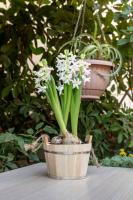Introduction
Planting cherry trees is an exciting activity for gardeners and farmers alike. It is a great investment for your garden or farm because it can provide you with fresh and delicious fruits. However, planting cherry trees requires careful planning and preparation. One important factor to consider is the distance between each tree. In this article, we will discuss how far apart you should plant cherry trees for optimal growth and fruit production.
Factors to Consider
The distance between cherry trees depends on several factors, including the tree variety, the soil quality, and the climate. Different cherry tree varieties have different growth patterns and require different spacing. Some cherry trees tend to grow larger and taller, while others are more compact. Soil quality also affects the spacing because trees growing in poor quality soil may need more space for their roots to grow. The climate also plays a role because trees growing in colder climates need more space to receive enough sunlight and warmth for proper growth.
Spacing for Dwarf and Semi-Dwarf Cherry Trees
Dwarf and semi-dwarf cherry trees are smaller in size and require less space than standard cherry trees. For these varieties, a distance of 10-15 feet between trees is sufficient. This spacing allows the trees to grow and produce fruits without interfering with each other's growth. Dwarf and semi-dwarf cherry trees are ideal for small gardens or areas with limited space.
Spacing for Standard Cherry Trees
Standard cherry trees are larger and require more space than dwarf and semi-dwarf varieties. For these trees, a distance of 20-25 feet between trees is recommended. This spacing allows the trees to grow tall and wide, producing more branches and leaves. Standard cherry trees are ideal for large gardens or farms because they can produce more fruits than smaller varieties.
Spacing for Pollinators
When planting cherry trees, it is important to consider the distance between pollinators. Pollination is the process by which fruits develop, and it requires insects to transfer pollen from one flower to another. Cherry trees are usually self-sterile, which means that they need a different variety of tree to effectively pollinate them. For this reason, it is important to plant pollinators within 50 feet of each other. This distance allows pollinating insects to move efficiently between trees and ensures a good fruit set.
Conclusion
Planting cherry trees requires careful planning and spacing. The distance between trees depends on several factors, including the tree variety, the soil quality, and the climate. Dwarf and semi-dwarf cherry trees require a spacing of 10-15 feet, while standard cherry trees require 20-25 feet. Pollinator trees should be planted within 50 feet of each other to ensure effective pollination. With proper spacing and care, cherry trees can provide you with delicious fruits for years to come.

 how many times do yo...
how many times do yo... how many planted tre...
how many planted tre... how many pine trees ...
how many pine trees ... how many pecan trees...
how many pecan trees... how many plants comp...
how many plants comp... how many plants can ...
how many plants can ... how many plants and ...
how many plants and ... how many pepper plan...
how many pepper plan...






























